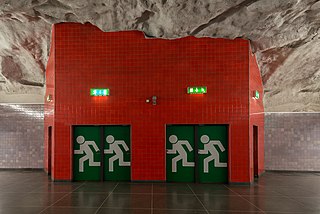 W
WA building code is a set of rules that specify the standards for constructed objects such as buildings and nonbuilding structures. Buildings must conform to the code to obtain planning permission, usually from a local council. The main purpose of building codes is to protect public health, safety and general welfare as they relate to the construction and occupancy of buildings and structures. The building code becomes law of a particular jurisdiction when formally enacted by the appropriate governmental or private authority.
 W
WConstruction Law is a monthly English-language journal providing news and articles on the construction industry. The journal is written for the non-legal professional involved in contractual and other legal matters in the industry. The journal is owned by LexisNexis which is part of Reed Elsevier.
 W
WAn emergency exit in a structure is a special exit for emergencies such as a fire: the combined use of regular and special exits allows for faster evacuation, while it also provides an alternative if the route to the regular exit is blocked by fire, etc.
 W
WThe Height of Buildings Act of 1899 was a U.S. height restriction law passed by the 55th Congress in response to advancements in construction technology, specifically the use of iron and steel frames, along with thin veneer facades, which made it possible to build lighter, and consequently much taller buildings. Residents of densely populated cities, including Washington D.C., felt that the new technology was untested and steel-framed structures may suffer "serious and fatal defects" due to corrosion from steam pipes and electrical wiring – another relatively recent advancement. They believed that these new tall buildings would ultimately collapse. In an 1899 Senatorial Report, Senator Warren Curtis speculated that, "the life of these structures might not be more than seventy-five years."
 W
WThe Height of Buildings Act of 1910 was an Act of Congress passed by the 61st United States Congress on June 1, 1910 to limit the height of buildings in District of Columbia, amending the Height of Buildings Act of 1899. The new height restriction law was more comprehensive than the previous law, and generally restricts building heights along residential streets to 90 feet (27 m), and along commercial corridors to the width of the right-of-way of the street or avenue on which a building fronts, or a maximum of 130 feet (40 m), whichever is shorter.
 W
WA "Little Miller Act" is a U.S. state statute, based upon the federal Miller Act, that requires prime contractors on state construction projects to post bonds guaranteeing the performance of their contractual duties and/or the payment of their subcontractors and material suppliers.
 W
WThe Miller Act requires prime contractors on some government construction contracts to post bonds guaranteeing both the performance of their contractual duties and the payment of their subcontractors and material suppliers.
 W
WPlanning permission or developmental approval refers to the approval needed for construction or expansion, and sometimes for demolition, in some jurisdictions. It is usually given in the form of a building permit.
 W
WPlanning permission in the United Kingdom is the planning permission required in the United Kingdom in order to be allowed to build on land, or change the use of land or buildings. Within the UK the occupier of any land or building will need title to that land or building, but will also need "planning title" or planning permission. Planning title was granted for all pre-existing uses and buildings by the Town and Country Planning Act 1947, which came into effect on 1 July 1948. Since that date any new "development" has required planning permission. "Development" as defined by law consists of any building, engineering or mining operation, or the making of a material change of use in any land or building. Certain types of operation such as routine maintenance of an existing building are specifically excluded from the definition of development. Specified categories of minor or insignificant development are granted an automatic planning permission by law, and therefore do not require any application for planning permission. These categories are referred to as permitted development.